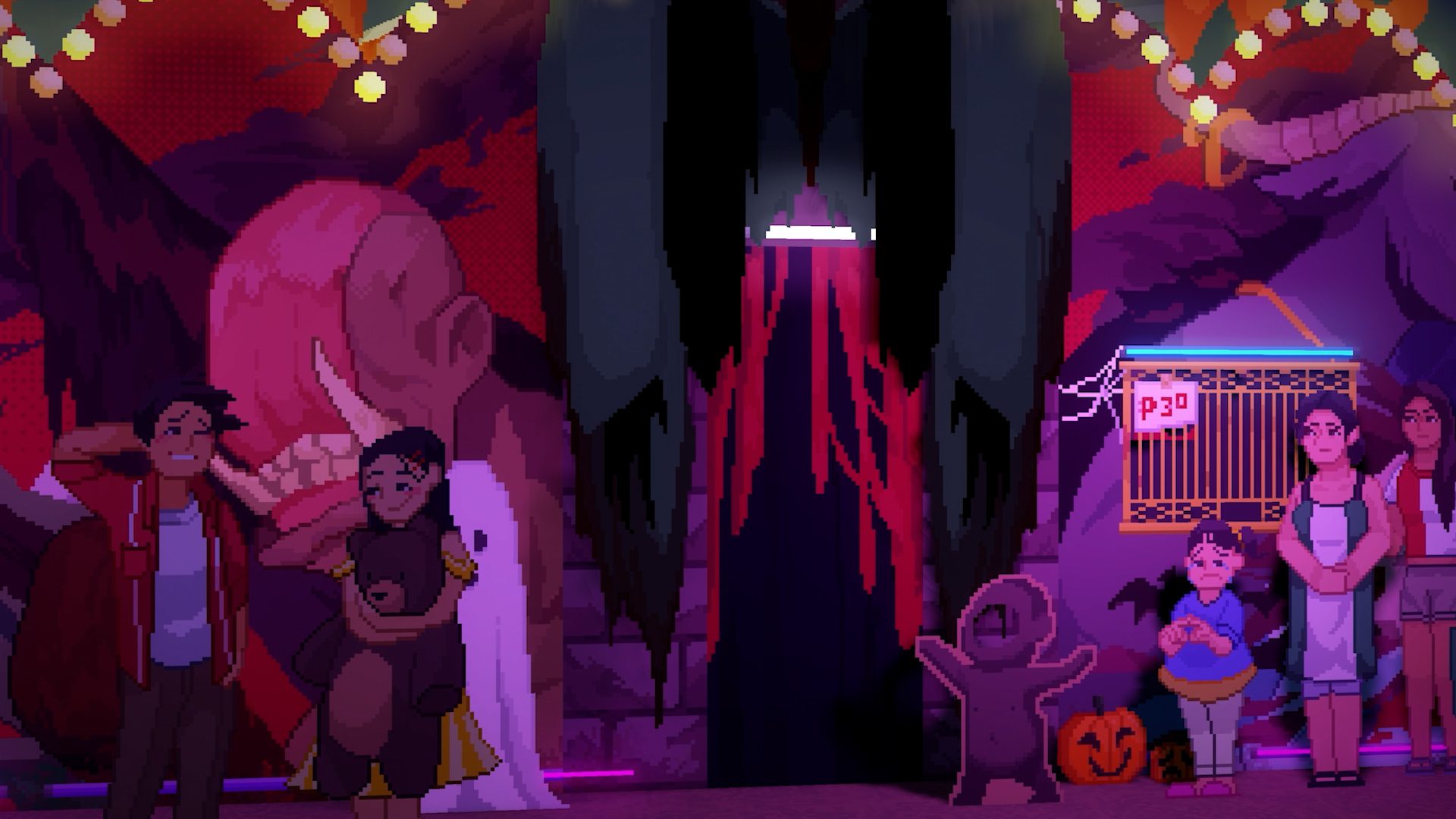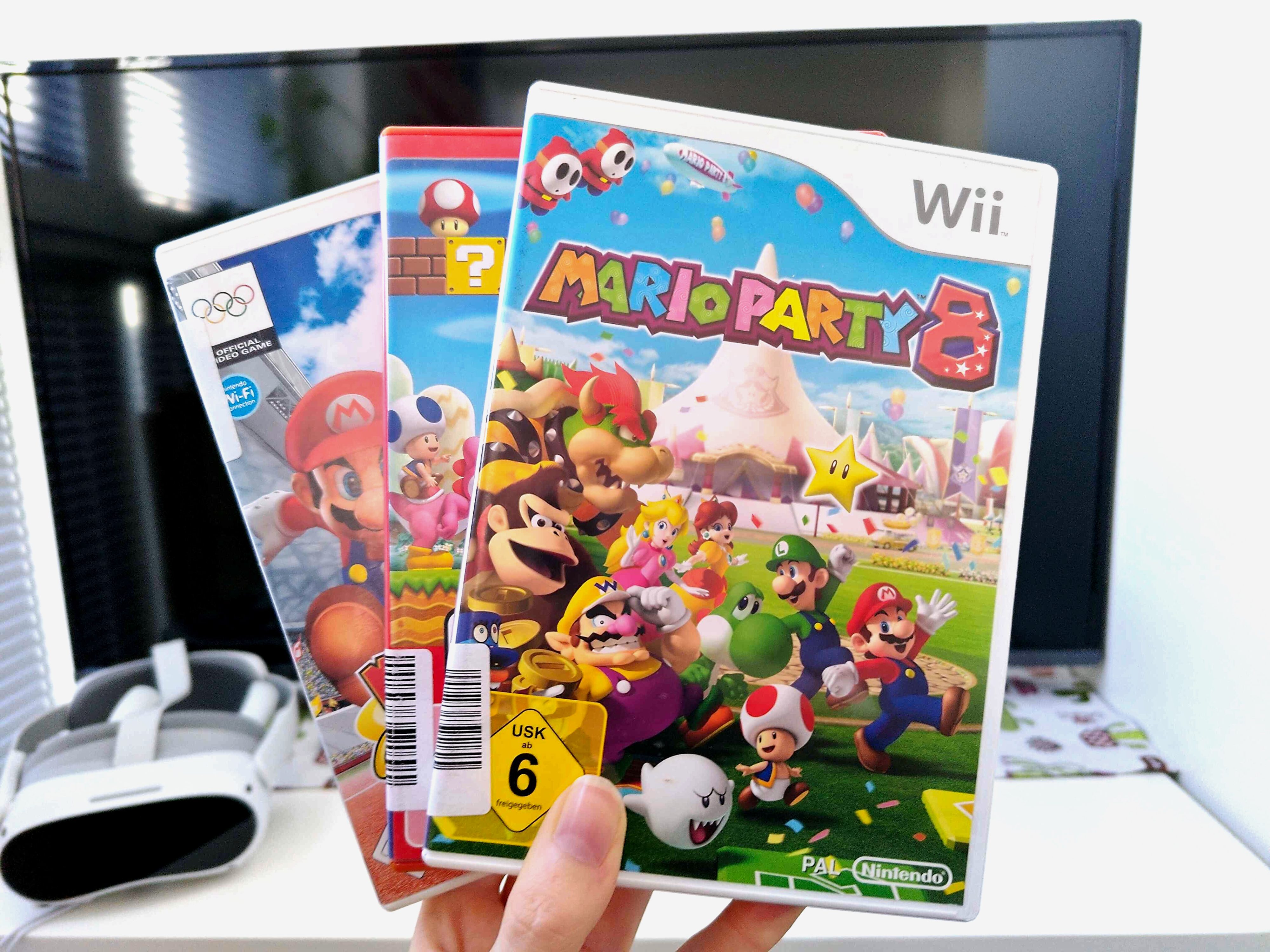
Until Then is a stunning narrative adventure set in a charming pixelated world inspired by the Philippines. Playing as protagonist Mark, you navigate day-to-day high school insecurities until he begins to realize something more mysterious is going on. Between juggling homework deadlines, navigating relationships, practicing piano, and investigating the strange occurrences happening in between, the developers also sprinkled endearing minigames throughout the story that create depth and delight out of what could have been just mundane moments.
For example, a walk to the fishball stand to subdue hunger pangs turns into a fierce competition for who can fill up their fishball stick the fastest. Getting extra meta, play the video game within a video game with Cathy & Mark to find out who is the fastest racer. And, of course, what would a carnival outing with friends be without all the classic fair games like whack-a-mole?
Beyond being just plain entertaining, Until Then’s minigames resonate in unique ways and those among the development team have their own opinions about which minigame stands out among the rest.
A minigame to create interactive worldbuilding
Mickole Klein Nulud, Game Director of Polychroma Games, has nostalgic ties to the ticket vending machine from chapter 1 of the game. “I’d always used them in my college days so it’s nostalgic,” said Nulud. “I replicated its user interface from the real world to the game in detail, which was a very fun process for me.”
Moments in the game like the ticket vending machine, were included to help break up the flow of the game’s dialogue-heavy nature and to create moments of interactive worldbuilding. “It sets up the tone of what kind of experience the player is going to get, where minigames can be as mundane as possible but true to life,” Nulud added.
A minigame to showcase character development
Senior Environment Artist Pia Demanawa’s favorite minigame, the haunted house in the perya, calls out to Filipino culture.‘Perya’ is a Tagalog word for ‘fair’, like a carnival. These week-long events take place throughout the year and are a unique part of Philippine celebrations. From game booths to rides to food stalls, a perya is a place of fun and entertainment for people of all ages.
Until Then brings this to life in chapter 10. Mark runs into one of the new students at the carnival and, after a bit of banter, bets that he can scare more people in the haunted house than she can. You then have two minutes to chase NPCs around the creepy maze, gaining points for each person successfully frightened.
“On its surface, [the haunted house] uses elements of Filipino mythology such as the Kiwig [a shapeshifter that preys on humans] and the Minokawa [a giant, dragon-like bird that can swallow the moon and sun],” Demanawa shared. “The designer for the art of the minigame itself, Vanessa Sumo, really encapsulated what a low-budget, Filipino-themed haunted house would look like from the inside with the stereotypical bahay kubo and the random chickens. The art director, Dominique Duran, additionally found inspiration for aesthetics from the 2012 RPGMaker horror game called Ib, and I thought that it was a wonderful homage to the cult-classic story game.”
Without spoiling too much, this competitive, haunted minigame creates a special moment for Mark, Until Then’s lead, telling more of the story not through the typical dialogue interaction but rather through character interaction within the minigame.
“Because of that, I don’t think the chapter is complete without it,” Demanawa added. “It’s needed to see the character development and charisma that bounces off of these two specific characters. It makes you happy for them, and, I think, it makes you root for them too.”
Minigames to foreshadow story events
Some minigames can be so subtle they might be easy to miss. Joshua James San Juan, Programmer, loves interacting with the school bulletin board. “It’s just fun and satisfying,” he shared, “like the ‘pop’ sound it makes when you remove the pins and watch the posters fall all over the place.”
For players who pay close attention to the details on the board, you might even find some enlightening clues to what’s coming later in the game. “I think it’s a clever way of showing or hinting at what events are happening and what will take place in the future without directly stating it,” San Juan said. “It also gives a little bit of lore on the setting of the story that will make them understand the world better.”
Minigames to just take a break
There are no surprises here. Kyle Patrick Naval is the game’s composer and has a particular fondness for the jeepney rhythm minigame. “I love playing rhythm games, and making music for that specific minigame was a super fun process,” he shared.
Some minigames might not necessarily have a narrative purpose but can add variety to the gameplay and give players a breather from intense moments. “I think it gives the character somewhat of a little break from what they are experiencing, enjoying the little things, as they say,” Naval said. “It gives the player new minigames to explore and play, and to look forward to what else they might discover in the game.”
There’s never a dull moment in Until Then. From friendly competition and compelling minigame mechanics to breathtaking scenery and tear-jerking story moments, expect a rollercoaster of emotions and interactions. Until Then launches this Summer on PS5.
Until Then is a stunning narrative adventure set in a charming pixelated world inspired by the Philippines. Playing as protagonist Mark, you navigate day-to-day high school insecurities until he begins to realize something more mysterious is going on. Between juggling homework deadlines, navigating relationships, practicing piano, and investigating the strange occurrences happening in between, the developers also sprinkled endearing minigames throughout the story that create depth and delight out of what could have been just mundane moments.
For example, a walk to the fishball stand to subdue hunger pangs turns into a fierce competition for who can fill up their fishball stick the fastest. Getting extra meta, play the video game within a video game with Cathy & Mark to find out who is the fastest racer. And, of course, what would a carnival outing with friends be without all the classic fair games like whack-a-mole?
Beyond being just plain entertaining, Until Then’s minigames resonate in unique ways and those among the development team have their own opinions about which minigame stands out among the rest.
A minigame to create interactive worldbuilding
Mickole Klein Nulud, Game Director of Polychroma Games, has nostalgic ties to the ticket vending machine from chapter 1 of the game. “I’d always used them in my college days so it’s nostalgic,” said Nulud. “I replicated its user interface from the real world to the game in detail, which was a very fun process for me.”
Moments in the game like the ticket vending machine, were included to help break up the flow of the game’s dialogue-heavy nature and to create moments of interactive worldbuilding. “It sets up the tone of what kind of experience the player is going to get, where minigames can be as mundane as possible but true to life,” Nulud added.
A minigame to showcase character development
Senior Environment Artist Pia Demanawa’s favorite minigame, the haunted house in the perya, calls out to Filipino culture.‘Perya’ is a Tagalog word for ‘fair’, like a carnival. These week-long events take place throughout the year and are a unique part of Philippine celebrations. From game booths to rides to food stalls, a perya is a place of fun and entertainment for people of all ages.
Until Then brings this to life in chapter 10. Mark runs into one of the new students at the carnival and, after a bit of banter, bets that he can scare more people in the haunted house than she can. You then have two minutes to chase NPCs around the creepy maze, gaining points for each person successfully frightened.
“On its surface, [the haunted house] uses elements of Filipino mythology such as the Kiwig [a shapeshifter that preys on humans] and the Minokawa [a giant, dragon-like bird that can swallow the moon and sun],” Demanawa shared. “The designer for the art of the minigame itself, Vanessa Sumo, really encapsulated what a low-budget, Filipino-themed haunted house would look like from the inside with the stereotypical bahay kubo and the random chickens. The art director, Dominique Duran, additionally found inspiration for aesthetics from the 2012 RPGMaker horror game called Ib, and I thought that it was a wonderful homage to the cult-classic story game.”
Without spoiling too much, this competitive, haunted minigame creates a special moment for Mark, Until Then’s lead, telling more of the story not through the typical dialogue interaction but rather through character interaction within the minigame.
“Because of that, I don’t think the chapter is complete without it,” Demanawa added. “It’s needed to see the character development and charisma that bounces off of these two specific characters. It makes you happy for them, and, I think, it makes you root for them too.”
Minigames to foreshadow story events
Some minigames can be so subtle they might be easy to miss. Joshua James San Juan, Programmer, loves interacting with the school bulletin board. “It’s just fun and satisfying,” he shared, “like the ‘pop’ sound it makes when you remove the pins and watch the posters fall all over the place.”
For players who pay close attention to the details on the board, you might even find some enlightening clues to what’s coming later in the game. “I think it’s a clever way of showing or hinting at what events are happening and what will take place in the future without directly stating it,” San Juan said. “It also gives a little bit of lore on the setting of the story that will make them understand the world better.”
Minigames to just take a break
There are no surprises here. Kyle Patrick Naval is the game’s composer and has a particular fondness for the jeepney rhythm minigame. “I love playing rhythm games, and making music for that specific minigame was a super fun process,” he shared.
Some minigames might not necessarily have a narrative purpose but can add variety to the gameplay and give players a breather from intense moments. “I think it gives the character somewhat of a little break from what they are experiencing, enjoying the little things, as they say,” Naval said. “It gives the player new minigames to explore and play, and to look forward to what else they might discover in the game.”
There’s never a dull moment in Until Then. From friendly competition and compelling minigame mechanics to breathtaking scenery and tear-jerking story moments, expect a rollercoaster of emotions and interactions. Until Then launches this Summer on PS5.






